 To enhance service speed and avoid tariff delays, we've opened a US warehouse. All US orders ship directly from our US facility.
To enhance service speed and avoid tariff delays, we've opened a US warehouse. All US orders ship directly from our US facility.
| Cat. No. | Product Name | Field of Application | Chemical Structure |
|---|---|---|---|
| DC73842 | sAKZ692 |
sAKZ692 (sAKZ-692) is a small molecule activator of NRF2 transcriptional activity (EC50=2.2 uM) in cells by inhibiting the glycolytic enzyme pyruvate kinase.
More description
|

|
| DC73841 | S217879 |
S217879 (S 217879) is a highly potent and selective NRF2 activator, binds to KEAP1 Kelch domain (SPR Kd=4.15 nM), disrupts the KEAP1-NRF2 interaction leading to robust NRF2 pathway activation.
More description
|

|
| DC73840 | BC-1901S |
BC-1901S is a potent small molecule NRF2 activator that stabilizes NRF2 and increases NRF2 activity, activates NRF2 by inhibiting NRF2 ubiquitination in a KEAP1-independent manner.
More description
|

|
| DC70623 | MSU38225 Featured |
MSU 38225 (MSU-38225) is a novel small molecule that inhibit the Nrf2 pathway, potentially inhibiting Nrf2 transcriptional activity and cancer cell growth;
MSU38225 downregulates Nrf2 transcriptional activity and decreases the expression of Nrf2 downstream targets, including NQO1, GCLC, GCLM, AKR1C2, and UGT1A6.
MSU38225 strikingly decreases the protein level of Nrf2, which can be blocked by the proteasome inhibitor MG132.
Ubiquitination of Nrf2 is enhanced following treatment with MSU38225.
By inhibiting production of antioxidants, MSU38225 increases the level of reactive oxygen species (ROS) when cells are stimulated with tert-butyl hydroperoxide (tBHP).
MSU38225 also inhibits the growth of human lung cancer cells in both two-dimensional cell culture and soft agar.
More description
|

|
| DC40756 | CBR-470-1 Featured |
CBR-470-1 is an inhibitor of the glycolytic enzyme phosphoglycerate kinase 1 (PGK1). CBR-470-1 is also a non-covalent Nrf2 activator. CBR-470-1 protects SH-SY5Y neuronal cells against MPP+-induced cytotoxicity through activation of the Keap1-Nrf2 cascade.
More description
|
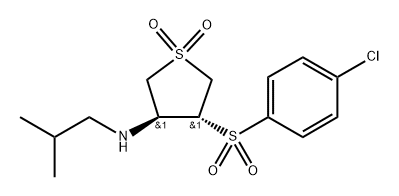
|
| DC70491 | HPPE Featured |
HPPE is a specific nonelectrophilic and physiological Bach1 inhibitor via heme-binding sites of Bach1 protein, derepresses Bach1-mediated repression.HPPE induces up-regulation of Hmox1 mRNA is mediated by Bach1 inhibition in vivo.
More description
|
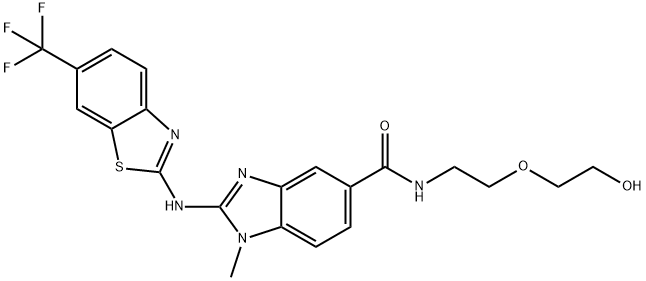
|
| DC70709 | PRL-295 Featured |
PRL295 is a small molecule Keap1-Nrf2 protein–protein interaction inhibitor.PRL295 binds to Keap1 in the cellular environment, disrupting its interaction with Nrf2, which leads to enhanced gene expression of the classical Nrf2 target NQO1 in cells and in vivo in the mouse liver.PRL-295 increases the thermostability of Keap1 in cell lysates and in live cells.PRL 295 decreased the levels of plasma alanine aminotransferase and aspartate aminotransferase upon acetaminophen-induced hepatic injury.
More description
|
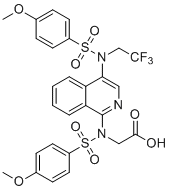
|
| DC10282 | ML385 Featured |
ML385 is a novel and specific NRF2 inhibitor.
More description
|
|
| DCAPI1084 | Ezetimibe (Zetia) Featured |
Ezetimibe (SCH 58235) is a potent cholesterol absorption inhibitor. Ezetimibe is a Niemann-Pick C1-like1 (NPC1L1) inhibitor, and is a potent Nrf2 activator.
More description
|

|
| DC4135 | Bardoxolone methyl Featured |
Bardoxolone methyl (also known as “RTA 402” and “CDDO-methyl ester”) is an orally-available first-in-class synthetic triterpenoid belonging to the antioxidant inflammation modulator (AIM) class.
More description
|

|
| DC71563 | NXPZ-2 |
NXPZ-2 is an orally active Keap1-Nrf2 protein–protein interaction (PPI) inhibitor with a Ki value of 95 nM, EC50 value of 120 and 170 nM. NXPZ-2 can dose-dependently ameliorate Aβ[1-42]-Induced cognitive dysfunction, improve brain tissue pathological changes in Alzheimer’s disease (AD) mouse by increasing neuron quantity and function. NXPZ-2 can inhibit oxidative stress by increasing Nrf2 expression levels and promoting its cytoplasm to nuclear translocation, which is helpful for Keap1-Nrf2 PPI inhibitors and AD associated disease research.
More description
|

|
| DC71029 | DDO-7263 |
DDO-7263, a 1,2,4-Oxadiazole derivative, is a potent Nrf2 activator. DDO-7263 upregulates Nrf2 through binding to Rpn6 to block the assembly of 26S proteasome and the subsequent degradation of ubiquitinated Nrf2. DDO-7263 activates the Nrf2-ARE signaling pathway and exerts anti-inflammatory activity.
More description
|

|
| DC70539 | KI-696 |
KI-696 (KI696) is a highly potent, selective inhibitor of KEAP1-NRF2 interaction, exhibits very high affinity for the KEAP1 Kelch domain with ITC Kd of 1.3 nM.KI-696 displays high selectivity against a panel of 49 in vitro functional assays for targets, with the exception of the OATP1B1 (IC50=2.5 µM), the bile salt export pump BSEP (IC50=4.0 µM), and PDE3A (IC50=10 uM).KI-696 increases NRF2 nuclear translocation in normal human bronchial epithelial cells, up-regulates NRF2-dependent gene expression NQO1 and GCLM, and increases NQO1 activity in an NRF2-dependent manner.KI-696 significantly reduces ozone-induced pulmonary inflammation, restores ozone-induced depletion of lung GSH levels in vivo.
More description
|

|
| DC70317 | Cobalt protoporphyrin IX chloride |
Cobalt protoporphyrin IX (CoPPIX) is a potent and effective inducer of HO-1 (heme oxygenase-1) activity, up-regulates HO-1 via Bach1 and Nrf2 in human liver cells.CoPPIX did not influence hepatic Bach1 or Nrf2 mRNA levels, but markedly reduced Bach1 protein levels by increasing degradation of Bach1 protein, and increased Nrf2 by decreasing degradation of Nrf2 protein.CoPPIX significantly upregulated HO-1 protein in mucosal and submucosal cells.CoPPIX is a direct Bach1 inhibitor.
More description
|

|
| DC48264 | Nrf2 activator-1 |
Nrf2 activator-1 is a potent activator of NF-E2 related factor 2 (Nrf2). Nrf2 activator-1 has the potential for the treatment of COPD and other respiratory diseases, including asthma, Acute Lung Injury (ALI), Acute Respiratory Distress Syndrome (ARDS) and pulmonary fibrosis (extracted from patent WO2018109647A1).
More description
|

|
| DC8198 | RTA-408(Omaveloxolone) Featured |
RTA-408 is a synthetic triterpenoid that potently activates the antioxidative transcription factor Nrf2 and inhibits the proinflammatory transcription factor NF-κB.
More description
|
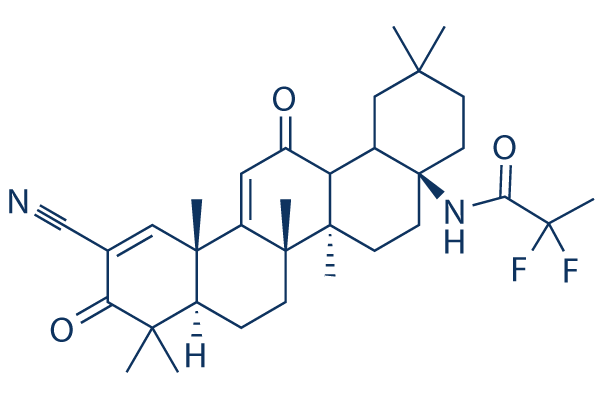
|
| DC47588 | Keap1-Nrf2-IN-3 |
Keap1-Nrf2-IN-3 is a KEAP1:NRF2 protein−protein interaction inhibitor, and with a Kd value of 2.5 nM for KEAP1 protein.
More description
|

|
| DC46235 | Keap1-Nrf2-IN-1 TFA |
Keap1-Nrf2-IN-1 TFA (compound35) is a Kelch-like ECH-associated protein 1-nuclear factor erythroid 2-related factor 2 (Keap1-Nrf2) protein-protein interaction inhibitor, and with an IC50 of 43 nM for Keap1 protein. Keap1-Nrf2-IN-1 TFA activates Nrf2-regulated cytoprotective response and antagonizes acetaminophen-induced liver injury both in cellular and in vivo models.
More description
|

|
| DC45882 | Dehydrocurdione |
Dehydrocurdione, a zedoary-derived sesquiterpene, induces heme oxygenase (HO)-1, an antioxidative enzyme, in RAW 264.7 macrophages. Dehydrocurdione interacts with Keap1, resulting in Nrf2 translocation followed by activation of the HO-1 E2 enhancer. Dehydrocurdione suppresses lipopolysaccharide-induced NO release, a marker of inflammation. Anti-inflammatory activity.
More description
|

|
| DC43986 | Dibenzoylmethane |
Dibenzoylmethane, a minor ingredient in licorice, activates Nrf2 and prevents various cancers and oxidative damage. Dibenzoylmethane, an analog of curcumin, results in dissociation from Keap1 and nuclear translocation of Nrf2.
More description
|

|
| DC41779 | TAT-14 TFA |
TAT-14 TFA?is a 14-mer peptide that acts as?Nrf2?activator with an anti-inflammatory effect. TAT-14 TFA has no effect on Nrf2 mRNA expression, but increases Nrf2 protein level due to targeting the Nrf2 binding site on Keap1.
More description
|

|
| DC41778 | TAT-14 |
TAT-14 is a 14-mer peptide that acts as?Nrf2?activator with an anti-inflammatory effect. TAT-14 has no effect on Nrf2 mRNA expression, but increases Nrf2 protein level due to targeting the Nrf2 binding site on Keap1.
More description
|

|
| DC41436 | Toralactone |
Toralactone, isolated from Cassia obtusifolia, mediates hepatoprotection via an Nrf2-dependent anti-oxidative mechanism.
More description
|

|
| DC41378 | (S)-Falcarinol |
(S)-Falcarinol ((S)-Panaxynol), one of the major polyacetylenes isolated from Panax ginseng, has antitumor activity. (S)-Falcarinol is the most potent antiplatelet agent in ginseng and its mechanism of action is chiefly due to the inhibition of thromboxane formation. (S)-Falcarinol is a potent Nrf2 activator.
More description
|

|
| DC40751 | CBR-470-2 |
CBR-470-2, a glycine-substituted analog, and can activate NRF2 signaling. CBR-470-2 can be used for modulation glycolysis.
More description
|

|
| DC40359 | Keap1-Nrf2-IN-1 |
Keap1-Nrf2-IN-1 (compound35) is a Kelch-like ECH-associated protein 1-nuclear factor erythroid 2-related factor 2 (Keap1-Nrf2) protein-protein interaction inhibitor, and with an IC50 of 43 nM for Keap1 protein. Keap1-Nrf2-IN-1 activates Nrf2-regulated cytoprotective response and antagonizes acetaminophen-induced liver injury both in cellular and in vivo models.
More description
|

|
| DC28729 | Ezetimibe ketone |
Ezetimibe ketone (EZM-K) is a phase-I metabolite of Ezetimibe. Ezetimibe is a Niemann-Pick C1-like1 (NPC1L1) inhibitor, and is a potent Nrf2 activator. Ezetimibe is a potent cholesterol absorption inhibitor.
More description
|

|
| DC28273 | ML334 |
ML334 is a potent, cell permeable activator of NRF2 by inhibition of Keap1-NRF2 protein-protein interaction. ML334 binds to Keap1 Kelch domain with a Kd of 1 μM. ML334 stimulates NRF2 expression and nuclear translocation and induces antioxidant response elements (ARE) activity.
More description
|

|
| DC10913 | Brusatol |
Brusatol (NSC 172924, (+)-Brusatol) is a quassinoid extracted from Brucea Esters, can inhibit HIF-1 signaling pathway, also is a potent Nrf2 inhibitor.
More description
|
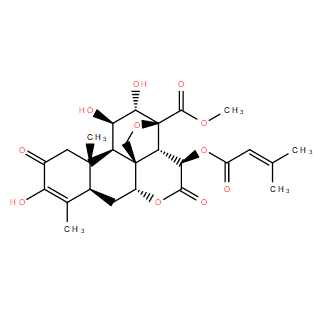
|
| DC11499 | BPK-29 |
BPK-29 is a covalent, specific small molecule that disrupts NR0B1 protein complexes and impairs the anchorage-independent growth of KEAP1-mutant cancer cells.
More description
|
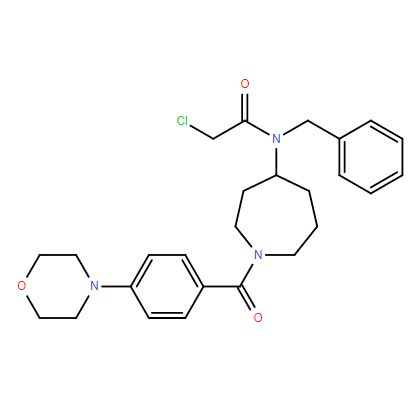
|